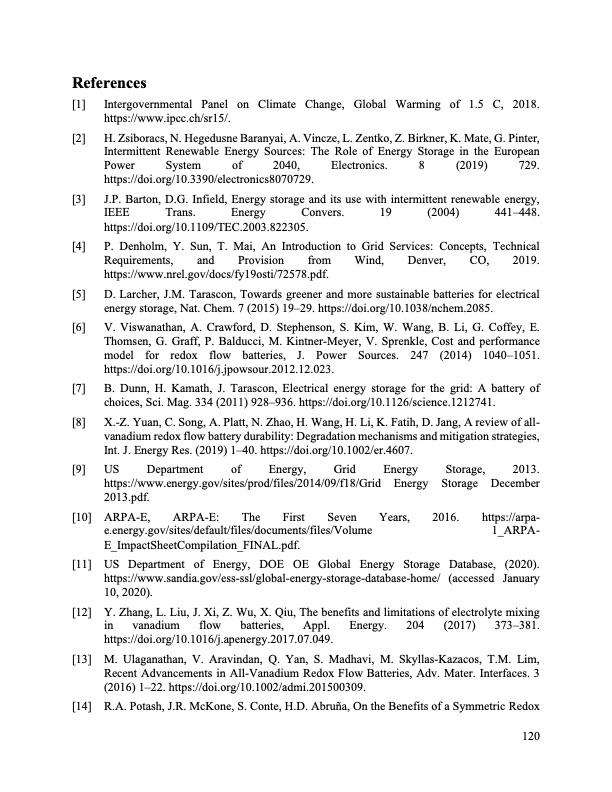
PDF Publication Title:
Text from PDF Page: 120
References [1] Intergovernmental Panel on Climate Change, Global Warming of 1.5 C, 2018. https://www.ipcc.ch/sr15/. [2] H. Zsiboracs, N. Hegedusne Baranyai, A. Vincze, L. Zentko, Z. Birkner, K. Mate, G. Pinter, Intermittent Renewable Energy Sources: The Role of Energy Storage in the European Power System of 2040, Electronics. 8 (2019) 729. https://doi.org/10.3390/electronics8070729. [3] J.P. Barton, D.G. Infield, Energy storage and its use with intermittent renewable energy, IEEE Trans. Energy Convers. 19 (2004) 441–448. https://doi.org/10.1109/TEC.2003.822305. [4] P. Denholm, Y. Sun, T. Mai, An Introduction to Grid Services: Concepts, Technical Requirements, and Provision from Wind, Denver, CO, 2019. https://www.nrel.gov/docs/fy19osti/72578.pdf. [5] D. Larcher, J.M. Tarascon, Towards greener and more sustainable batteries for electrical energy storage, Nat. Chem. 7 (2015) 19–29. https://doi.org/10.1038/nchem.2085. [6] V. Viswanathan, A. Crawford, D. Stephenson, S. Kim, W. Wang, B. Li, G. Coffey, E. Thomsen, G. Graff, P. Balducci, M. Kintner-Meyer, V. Sprenkle, Cost and performance model for redox flow batteries, J. Power Sources. 247 (2014) 1040–1051. https://doi.org/10.1016/j.jpowsour.2012.12.023. [7] B. Dunn, H. Kamath, J. Tarascon, Electrical energy storage for the grid: A battery of choices, Sci. Mag. 334 (2011) 928–936. https://doi.org/10.1126/science.1212741. [8] X.-Z. Yuan, C. Song, A. Platt, N. Zhao, H. Wang, H. Li, K. Fatih, D. Jang, A review of all- vanadium redox flow battery durability: Degradation mechanisms and mitigation strategies, Int. J. Energy Res. (2019) 1–40. https://doi.org/10.1002/er.4607. [9] US Department of Energy, Grid Energy Storage, 2013. https://www.energy.gov/sites/prod/files/2014/09/f18/Grid Energy Storage December 2013.pdf. [10] ARPA-E, ARPA-E: The First Seven Years, 2016. https://arpa- e.energy.gov/sites/default/files/documents/files/Volume 1_ARPA- E_ImpactSheetCompilation_FINAL.pdf. [11] US Department of Energy, DOE OE Global Energy Storage Database, (2020). https://www.sandia.gov/ess-ssl/global-energy-storage-database-home/ (accessed January 10, 2020). [12] Y. Zhang, L. Liu, J. Xi, Z. Wu, X. Qiu, The benefits and limitations of electrolyte mixing in vanadium flow batteries, Appl. Energy. 204 (2017) 373–381. https://doi.org/10.1016/j.apenergy.2017.07.049. [13] M. Ulaganathan, V. Aravindan, Q. Yan, S. Madhavi, M. Skyllas-Kazacos, T.M. Lim, Recent Advancements in All-Vanadium Redox Flow Batteries, Adv. Mater. Interfaces. 3 (2016) 1–22. https://doi.org/10.1002/admi.201500309. [14] R.A. Potash, J.R. McKone, S. Conte, H.D. Abruña, On the Benefits of a Symmetric Redox 120PDF Image | Bringing Redox Flow Batteries to the Grid

PDF Search Title:
Bringing Redox Flow Batteries to the GridOriginal File Name Searched:
Rodby-krodby-phd-chemE-2022-thesis.pdfDIY PDF Search: Google It | Yahoo | Bing
Salgenx Redox Flow Battery Technology: Salt water flow battery technology with low cost and great energy density that can be used for power storage and thermal storage. Let us de-risk your production using our license. Our aqueous flow battery is less cost than Tesla Megapack and available faster. Redox flow battery. No membrane needed like with Vanadium, or Bromine. Salgenx flow battery
| CONTACT TEL: 608-238-6001 Email: greg@salgenx.com | RSS | AMP |